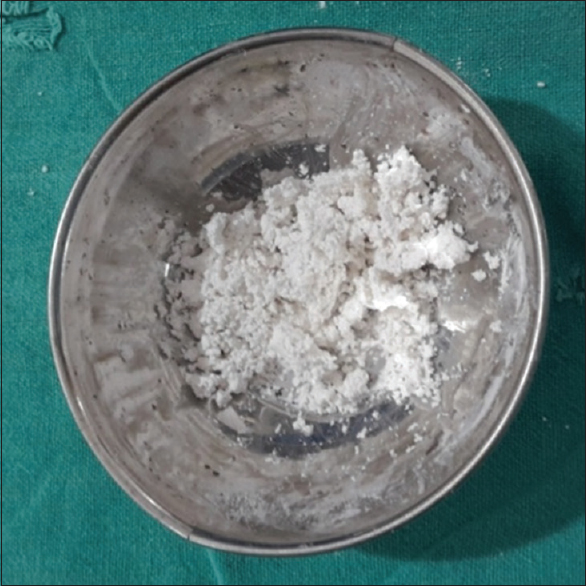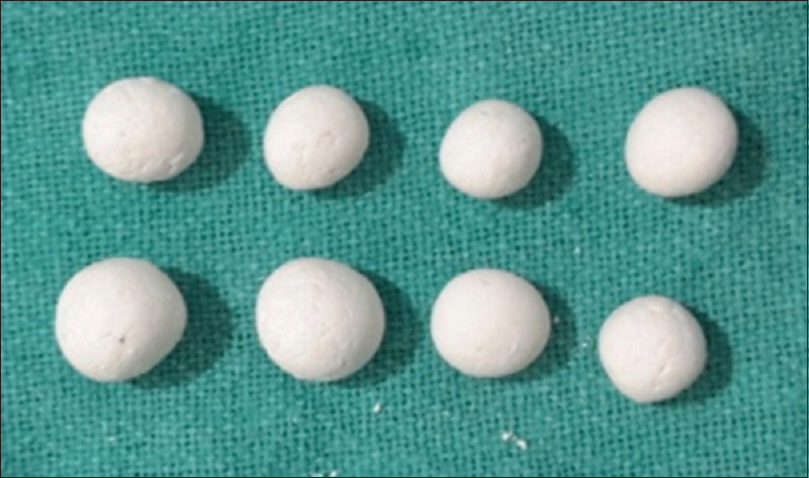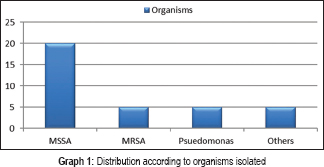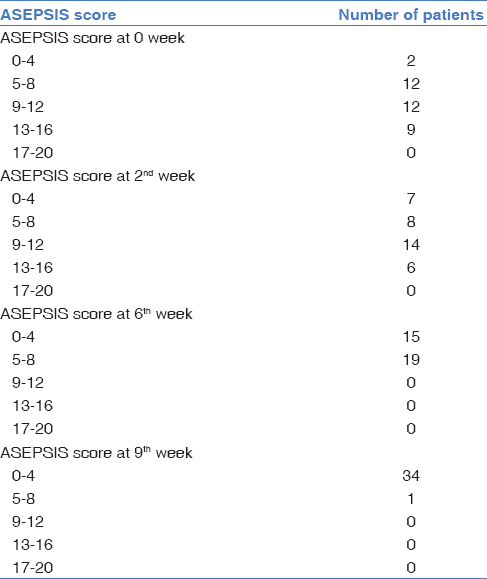Translate this page into:
Use of biodegradable materials as local antimicrobial carriers in orthopedic infections
Address for correspondence: Dr. Suvarn Gupta, 10, “Shubh Swarn” bldg., Bajiprabhunagar, Near Ramnagar, Nagpur - 440 033, Maharashtra, India. E-mail: suvarn27@gmail.com
-
Received: ,
Accepted: ,
This article was originally published by Wolters Kluwer - Medknow and was migrated to Scientific Scholar after the change of Publisher.
How to cite this article: Waghmare A, Saxena NK, Gupta S, Khan S. Use of biodegradable materials as local antimicrobial carriers in orthopedic infections. J Orthop Spine 2019;7:51-6.
Abstract
INTRODUCTION:
Orthopedic infections have been a major complication; despite numerous advances in prophylactic measures, infections still remain a major complication in orthopedic and trauma surgery. The progressive infection of the bone and the surrounding tissue results in bone infarcts with abscess and sequestrum formation. Adequate treatment can be an implant removal and a radical debridement with a long-term course of systemic antibiotic, but these prolonged therapies can result in side effects or toxicity. The primary reason for using local antibiotic delivery vehicles is its ability to achieve high local concentrations without associated systemic toxicity.
MATERIALS AND METHODS:
This is a prospective study conducted over 2 years. Thirty-five patients were studies in which 33 patients were managed with calcium sulfate + antibiotic, 1 was managed prophylactically with beads, and one was managed with Abgel + antibiotic as a biodegradable carrier. The aim was to evaluate the efficacy of biodegradable materials as antimicrobial carriers in localized orthopedic infection.
OBSERVATIONS:
A prospective study consists of 35 cases of orthopedic infections with major number of patients belonged to the age group of 20–40 years, with a mean 37.66 ± 19.9 years. One patient was included with soft tissue infection and rest all the patients had bone infections. It was observed that there is statistically significant improvement in ASEPSIS score at 0 week to ASEPSIS score at the end of 9 weeks.
CONCLUSION:
In the present study, the patients showed evidence of excellent control of infection and osseous repair, and further, none of the patients required follow-up. In our series, we have used calcium sulfate as a biodegradable antimicrobial carrier with appropriate antibiotics and achieved good-to-excellent results in local orthopedic infections.
Keywords
Biodegradable antibiotic beads
bone infection
osteomyelitis
Introduction
Orthopedic infections have been a major complication; despite numerous advances in prophylactic measures, infections still remain a major complication in orthopedic and trauma surgery.[1]
The progressive infection of the bone and the surrounding tissue results in an intense inflammatory response, causing local thrombosis and weakening of the blood supply. This provokes an undersupply of oxygen and shortage of nutrition to the bone and the surrounding tissue, resulting in bone infarcts with abscess and sequestrum formation.[2] Furthermore, the incoming amount of the antibiotic is limited and ends in a poor local antibiotic concentration, especially in the infected bone itself. In these isolated infected areas, bacteria can multiply almost without meeting any resistance and are able to form biofilms that add additional protection against antibodies and antibiotic therapy.[3] Biofilm formation results in a need for 10–100 times increased antibiotic concentrations to cross the barrier to fight bacteria.[4,5] All these factors together and in different combinations lead to the formation of necrotic bone and sequestrum. For adequate treatment of chronic local orthopedic infection in the presence of biofilm, complete implant removal and radical surgical debridement are necessary, and to ensure mechanical stability after removal of the implant, an external fixation is necessary.[6] A long-term course of systemic antibiotic therapy has been considered essential, but these prolonged therapies can result in side effects or toxicity.
The primary reason for using local antibiotic delivery vehicles is its ability to achieve high local concentrations without associated systemic toxicity. In the typical infected wound environment which frequently has zones of avascularity, ability to achieve high levels of antibiotics in these otherwise inaccessible areas is highly desirable.[7] Additional reasons for the use of these delivery vehicles include the desire to treat remaining planktonic organisms and sessile organisms in biofilms more effectively with high concentrations of antibiotics.[8]
A primary advantage of a biodegradable carrier is the avoidance of secondary surgical procedures for removal. As traditional bone cement beads are required to be removed once antibiotic elution has ceased. Biodegradable implants loaded with antibiotics provides high local bactericidal concentrations in tissue for the prolonged time, needed to completely eradicate the infection and the possibility to match the rate of implant biodegradability according to the type of infection treated.[9] Biodegradable implant can also be used initially to obliterate the dead space and eventually to guide its repair.
Materials and Methods
This is a prospective study conducted in the Department of Orthopaedics, Acharya Vinobha Bhave Rural Hospital (Sawangi), Wardha, over 2 years. Thirty-five patients were studies in which 33 patients were managed with calcium sulfate + antibiotic, one was managed prophylactically with beads, and one was managed with Abgel + antibiotic as a biodegradable carrier.
Aim
To evaluate the efficacy of biodegradable materials as antimicrobial carriers in localized orthopedic infection.
Inclusion criteria
All the cases of localized orthopedic infections, above 5 years of the age, which are not responding to routine systemic and local antimicrobial treatment, attending Acharya Vinobha Bhave Rural Hospital
Prophylactic in patients who are coming with badly contaminated compound fracture where infection is anticipated
Patients who are willing for this treatment modality and follow-up protocol for evaluation.
Exclusion criteria
Those who are not willing for regular follow-up
Immunocompromised patient
Patient with renal and hepatic failure and other comorbid conditions where use of such antibiotics is restricted.
Statistical analysis was performed in “ Statistical Package for the social sciences” (SPSS) software, Version 21, DMIMS, Nagpur, Maharashtra, India. Variable were categorized in scale, nominal and ordinal. Chi-square test, Student's t-test, and Pearson's correlation test were done to analyze different variables.
Procedure
The biodegradable antimicrobial bead was prepared under all aseptic precautions with appropriate antibiotic and in desired shapes (hand molded) [Figures 1-3]. Ten grams of calcium sulfate mixed with 1 gram vancomycin (powdered form) with approximately 5 milliliters of Normal Saline (0.9% NaCl) was sterilized in Ethylene Oxide sterilization chamber for 8 hours. The setting time of these calcium beads was approximately 6–8 hours. These antibiotic-impregnated biodegradable beads have been used in bone as well as soft tissue infection in orthopedics cases.

- Mixture of calcium sulfate and vancomycin mixed with NS (sodium chloride 0.9%) to the shown consistency

- Biodegradable antimicrobial pellets were made in desired shape and size (hand-molded) according to the required area for implantation

- ETO-sterilized biodegradable antimicrobial beads
All the patients were treated surgically with debridement and introduction of antibiotic-impregnated calcium sulfate beads based on culture sensitivity. When bacterial culture was no growth, then vancomycin was used, and systemic antibiotic delivered was based on final cultures at the time of surgical debridement. Postoperatively, patients were followed up for maximum of 9 weeks because antimicrobial beads take maximum of 9 weeks to completely dissolve into the body and after which have no role in the control of infection.
The patient's ASEPSIS score [Table 1] was noted at every 0, 2, 6, and 9 weeks, and the patients were given routine additional antibiotics and dressing as a protocol in our hospital.

The ASEPSIS score thus derived was based on clinical examination of the above-mentioned four clinical parameters.
Observations
A prospective study consists of 35 cases of orthopedic infections. All the cases were available for follow-up. Out of 35, there were 30 (85%) males and 5 (15%) females. Most number of patients belonged to the age group of 20–40 years, with a mean 37.66 ± 19.9 standard deviation. One patient was included with soft tissue infection and rest all the patients had bone infections.
Fifty-eight percent of the patients had Staphylococcus aureus infections which were sensitive to vancomycin, 14% of patients showed growth of methicillin-resistant S. aureus, 14% were Pseudomonas, and rest 14% showed growth of other organisms.[Graph 1].

Fortyeight percent of the patients showed involvement of tibia, 34% patients showed involvement of femur. In 8% patients, foot was involved, and in rest 8%, other areas were involved. Seventy-four percent patients presented to us with discharging sinus while 26% presented with open wound.
Evaluation of results at follow-up was done using ASEPSIS score.
Thus, it was observed that there is statistically significant improvement in ASEPSIS score at 0 week to ASEPSIS score at the end of 9 weeks (P = 0.00) [Table 2].

In our study, the pellets were no longer able to be seen on radiographs at 1 month (15 cases) and 2 months (20 cases). Therefore, all the pellets had completely resorbed by 2 months postoperatively, with the averWWage time of resorption being 1.4 months (range, 1–2 months).
In all patients, the local antibiotic calcium sulfate implants fully biodegraded. In all patients, the bone showed progressive repair without evidence of either residual or new osteolysis. No patient had significant drainage or adverse reaction to the local antibiotic implants.
Discussion
Chronic orthopedic infections of the bone and surrounding soft tissue represents inflammatory and progressive bacterial infections are difficult to manage. It was first described in 1852 by the French Surgeon Edouard Chassaignac in a case of a 2-year-old child.[4] However, already in the 17th century BC, osteomyelitis was specified in the Egyptian Edwin Smith Papyrus – probably the oldest trauma text in human history.[5]
Healthcare workers fear osteomyelitis due to its refractory nature, resulting in considerable morbidity and mortality [10,11] and high costs to the healthcare system.[12] Although efforts have been undertaken to reduce the incidence and consequences of osteomyelitis, a large proportion of the world population still suffers from chronic osteomyelitis, primarily because of a vast increase in reconstructive orthopedic procedures.[13] Furthermore, inadequate treatment of the acute phase allows osteomyelitis either to persist and become chronic or relatively “dormant” for a considerable time, only to recur at a later phase.
In our study, orthopedic infections occurred mostly in the age group of 20–60 years, with the youngest patient aged 8 years and oldest patient aged 87 years. It is comparable with similar studies done earlier.[14] Our study had a male preponderance with 30 males and five females which are similar to other studies.[9,14] Chronic osteomyelitis is intrinsically resistant to antibiotic therapy, even when caused by bacteria that are not clinically defined as resistant to the preferred antibiotics. This is mainly due to insufficient concentration of antibiotic at local site. S. aureus is by far the most common pathogenic microorganism causing chronic osteomyelitis, owing to its ability to adhere, invade tissue (by toxins and hydrolases), undermine host defenses, and invade mammalian cells.[15] Moreover, S. aureus and other pathogens involved in chronic osteomyelitis frequently form biofilms on necrotic bone and foreign bodies, in which they are extensively protected from host defenses and antimicrobial therapy by a slimy layer embedding the organisms. In our study, we found similar results Wthe patients but one was sensitive to vancomycin. In our study, vancomycin was used in most patients as supported by other studies being useful as local antimicrobials.[16]
The biodegradable antimicrobial pellets showed added advantage of no biofilm formation over the material and total dissolution of antimicrobials locally as opposed to the polymethylmethacrylate beads. Polymethylmethacrylate beads only carry antimicrobials on their surface, and after its release, if not removed, beads itself act as foreign material and form biofilm-harboring microorganisms.[5]
In our study, the most common bone infected was tibia followed by femur. It may be due to the most common involvement of tibia in road traffic accidents, least soft tissue coverage, and precarious blood supply.
The systemic antibiotic therapy of osteomyelitis is administered intravenously and orally. It requires an antibiotic agent matching the antibiogram of the bacteria. Systemic antibiotic treatment has potential for drug-related toxicity with organ failure, gastrointestinal side effects, allergic reactions, and the possible lack of reaching therapeutic concentrations in the infected area.[17] Because of poor penetration of bone at the infection site, a systemic antibiotic therapy is unable to eradicate the bacteria in a chronic state.
In Chronic Osteomyelitis, antibiotic treatment alone will fail if there is inadequate surgery or debridement.[18] The high risk of a continuous and recurrent infection explains the need for a systemic postoperative antibiotic therapy. According to the literature, a postoperative systemic antibiotic therapy is recommended for 4–6 weeks and is founded over 4 weeks for revascularization of bone grafts after resection and transplantation.[15,19]
Further problems occur with the increasing number of highly resistant bacteria such as methicillin-resistant S. aureus.[20] In our study, five patients were methicillin-resistant S. aureus positive treated by biodegradable local antimicrobial beads.
Biodegradable carriers can provide continuous and sustained high local antibiotic concentrations from the introduction up to 8 weeks, whereas antibiotic release from polymethylmethacrylate beads can diminish to values below the detection limit within 12 days. Furthermore, biodegradable carriers can release all of their antibiotic content.[9]
Calcium sulfate has been used since 1892 as an osteoconductive filler of bone defects.[21]
It also acts primarily as space filler, which restores morphological contour, prevents the ingrowth of soft tissue, and provides an osteoconductive matrix for the ingrowth of blood vessels. Surgical-grade calcium sulfate has been optimized to resorb at a rate similar to that of new bone formation. When placed in contact with bone or periosteum, calcium sulfate will stimulate bone growth. Even when loaded with vancomycin, calcium sulfate is still osteoconductive and improves bone healing.
The local delivery of antimicrobials for orthopedic infections has a potential advantage over standard systemic therapy. Not only does this biodegradable antibiotic implant obliterate the dead space, but it also delivers high dose of tissue antibiotics and aids in bone repair. Furthermore, these antimicrobial-impregnated beads do not require second procedure for removal of bead as in polymethylmethacrylate.
This study has an advantage of cost-effectiveness of total treatment and hospital stay of the patient being shortened with the biodegradable antimicrobial beads. Since the bone repair was substantial, follow-up surgery with autogenous iliac bone grafting and all its inherent problems hopefully can be avoided. Antimicrobial beads are easily hand-molded into desired shape and size so that they can be used in resistant infections. The complications encountered in two cases in our study were at 0–2 weeks a white color clear discharge coming out of the closure site. This was due to more than the required amount of calcium sulphate or due to excessive serous discharge because of foreign body reaction due to beads. The discharge spontaneously disappeared in 2 weeks.
Conclusion
Treatment of orthopedic infections has long been a controversial subject and remains a significant surgical challenge. Before the development of local antimicrobials agents, such cases were managed by the use of systemic antimicrobials agents with local surgical procedures.
Infection persisting in the soft tissue in the vicinity of bone lesion affects healing of the bone.
The local delivery of antibiotics for localized orthopedic infection has a potential advantage over standard systemic therapy. Not only do these biodegradable antibiotic carriers obliterate the dead space but also deliver high doses of antibiotics in tissue, controls infection, and aids in bone repair. Furthermore, it does not require removal like methylmethacrylate and has no possibility of biofilm formation around the beads as seen in polymethylmethacrylate.[22,23]
In the present study, the patients showed evidence of excellent control of infection and osseous repair, and further none required follow-up surgery such as autogenous iliac bone grafting despite the size of the defect. Full degradation of calcium sulfate pellets occurred in approximately 6–8 weeks, and healing occurred in an orderly manner. In our series, we have used calcium sulfate as biodegradable antimicrobial carriers with appropriate antibiotics and achieved good-to-excellent results in local orthopedic infections.
This method is low cost and easy to use, does not require much technique, and can be used in varied areas of orthopedic infections such as soft tissue, as well as bony infections, even with the presence of biofilm, implant, and necrotic bone. Beads can be made into desirable size, shapes, and quantity according to the infected areas/cavity.
To conclude, local antimicrobial agents are more effective in control of persistent orthopedic infections when used with selective biodegradable carriers.
Financial support and sponsorship
Nil.
Conflicts of interest
There are no conflicts of interest.
References
- Antibiotic-impregnated bone grafts in orthopaedic and trauma surgery: A systematic review of the literature. Int J Biomater. 2012;2012:538061.
- [CrossRef] [PubMed] [Google Scholar]
- Mechanisms of antibiotic resistance in bacterial biofilms. Int J Med Microbiol. 2002;292:107-13.
- [CrossRef] [PubMed] [Google Scholar]
- Gentamicin-PMMA beads. Pharmacokinetic and nephrotoxicological study. Clin Orthop Relat Res. 1986;205:171-83.
- [CrossRef] [Google Scholar]
- Antimicrobial treatment of chronic osteomyelitis. Clin Orthop Relat Res. 1999;360:47-65.
- [CrossRef] [PubMed] [Google Scholar]
- Biomaterial-associated infection of gentamicin-loaded PMMA beads in orthopaedic revision surgery. J Antimicrob Chemother. 2001;47:885-91.
- [CrossRef] [PubMed] [Google Scholar]
- Residual gentamicin-release from antibiotic-loaded polymethylmethacrylate beads after 5 years of implantation. Biomaterials. 2003;24:1829-31.
- [CrossRef] [PubMed] [Google Scholar]
- Infected tibial nonunions (1981-1995). The evolution of change. Clin Orthop Relat Res. 1999;360:97-105.
- [CrossRef] [PubMed] [Google Scholar]
- Local antibiotic delivery vehicles in the treatment of musculoskeletal infection. Clin Orthop Relat Res. 2005;437:91-6.
- [CrossRef] [PubMed] [Google Scholar]
- The use of calcium sulfate impregnated with vancomycin in the treatment of open fractures of long bones: A preliminary study. Orthopedics. 2010;33
- [CrossRef] [PubMed] [Google Scholar]
- A scoring method (ASEPSIS) for postoperative wound infections for use in clinical trials of antibiotic prophylaxis. Lancet. 1986;1:311-3.
- [CrossRef] [PubMed] [Google Scholar]
- Malignant lesions arising in chronic osteomyelitis. Clin Orthop Relat Res (362):181-9.
- [CrossRef] [Google Scholar]
- Savings from outpatient antibiotic therapy for osteomyelitis. Economic analysis of a therapeutic strategy. JAMA. 1986;255:1584-8.
- [CrossRef] [Google Scholar]
- Course and outcome of bacteremia due to Staphylococcus aureus: Evaluation of different clinical case definitions. Clin Infect Dis. 1993;16:567-73.
- [CrossRef] [PubMed] [Google Scholar]
- Does cement increase the risk of infection in primary total hip arthroplasty? Revision rates in 56,275 cemented and uncemented primary THAs followed for 0-16 years in the Norwegian arthroplasty register. Acta Orthop. 2006;77:351-8.
- [CrossRef] [PubMed] [Google Scholar]
- The use of an antibiotic-impregnated, osteoconductive, bioabsorbable bone substitute in the treatment of infected long bone defects: Early results of a prospective trial. J Orthop Trauma. 2002;16:622-7.
- [CrossRef] [PubMed] [Google Scholar]
- Physiology and antibiotic susceptibility of Staphylococcus aureus small colony variants. Microb Drug Resist. 2002;8:253-60.
- [CrossRef] [PubMed] [Google Scholar]
- Antibacterial and biocompatible properties of vancomycin-loaded nano-hydroxyapatite/collagen/poly (lactic acid) bone substitute. Progress in Natural Science: Materials International.. 2013;23:549-56.
- [CrossRef] [Google Scholar]
- Toxicities of antimicrobial agents used to treat osteomyelitis. Orthop Clin North Am. 1991;22:439-65.
- [CrossRef] [PubMed] [Google Scholar]
- Antibiotic delivery from calcium sulphate as a synthetic bone graft in a canine bone defect. Trans Soc Biomater. 1998;21:111.
- [Google Scholar]
- The treatment of chronic osteomyelitis with a biodegradable antibiotic-impregnated implant. J Orthop Surg (Hong Kong). 2002;10:53-60.
- [CrossRef] [PubMed] [Google Scholar]
- In vitro and in vivo testing of bioabsorbable antibiotic containing bone filler for osteomyelitis treatment. J Biomed Mater Res A. 2006;78:532-40.
- [CrossRef] [PubMed] [Google Scholar]
- In vitro evaluation of antibiotic diffusion from antibiotic-impregnated biodegradable beads and polymethylmethacrylate beads. Antimicrob Agents Chemother. 1997;41:415-8.
- [CrossRef] [PubMed] [Google Scholar]
- Effectiveness of local antibiotic delivery with an osteoinductive and osteoconductive bone-graft substitute. J Bone Joint Surg Am. 2005;87:107-12.
- [CrossRef] [PubMed] [Google Scholar]






